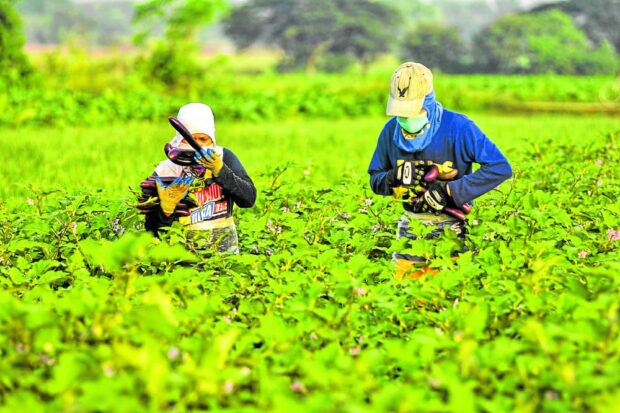Bill seeks to turn Maharlika Road to PH ‘National Food Highway’

CASH CROP | Farm workers harvest eggplants, which grow year-round, in Villasis, Pangasinan. The town, one of the top eggplant producers in the Ilocos region, is traversed by Daang Maharlika
(Pan-Philippine Highway), which a proposed measure in Congress wants to be turned into the “National Food Highway” to benefit farmers and agriculture-related businesses. (Photo by WILLIE LOMIBAO / Inquirer Northern Luzon)
MANILA, Philippines — Speaker Martin Romualdez has proposed declaring the Daang Maharlika (Maharlika Road, also known as Pan-Philippine Highway), the road network which stretches from Laoag City in northern Luzon to Zamboanga City in Mindanao, as the “National Food Highway” to perk up the country’s agriculture.
Romualdez, along with Tingog Sinirangan Representatives Yedda Marie Romualdez and Jude Acidre, filed House Bill No. 8197, or the proposed National Food Highway Act of 2023, aiming to utilize the 3,379.73-kilometer highway as a “platform” to develop agriculture-related businesses in local communities along the route.
“Agriculture is a vital sector of the Philippine economy, employing millions of Filipinos and contributing significantly to the country’s gross domestic product. However, the sector faces various constraints including the lack of efficient transportation and logistics systems for the timely and cost-effective delivery of agricultural products to the markets,” the lawmakers said.
They noted that by designating the Maharlika Highway as the country’s food highway, the government could use the major road network for transportation and distribution of agricultural products, particularly perishable goods, to “reduce postharvest losses, ensure food safety and quality and promote fair pricing for both farmers and consumers.”
They said this could also create more jobs and income opportunities for communities and promote the use of modern technologies and infrastructure in agriculture.
Article continues after this advertisementAgri competitiveness
“The declaration of the Maharlika Highway as the National Food Highway is a crucial step toward improving the efficiency and competitiveness of the agriculture sector in the country. It will help address the challenges faced by farmers and improve the overall welfare of the Filipino people,” they said.
Article continues after this advertisementHB 8197 defines the “national food highway” as “an integrated system for the processing, storage, transport, distribution and monitoring of food products along the Maharlika highway.”
In the proposed measure, the National Food Highway would cover food processing and storage facilities; transportation and distribution systems for food products; and a food monitoring system to ensure the safety and quality of products along the highway passing through the country’s major islands.
The bill would task the Department of Agriculture (DA) to work with the Department of Trade and Industry (DTI) and the private sector in setting up and managing food processing and storage facilities along the route.
The Department of Transportation (DOTr) would team up with the Department of Public Works and Highways (DPWH) to set up a food product transportation and distribution system on the highway while the Department of Health (DOH) would ensure food quality and safety by monitoring food processing and storage facilities for compliance with food safety standards, and regularly testing and analyzing food products transported and distributed along the route for contaminants and other harmful substances.
LGU tasks
Meanwhile, local government units (LGU) would be tasked with giving support for and assistance in the implementation of the National Food Highway within their areas, “including but not limited to the provision of necessary permits, licenses and regulatory compliance certificates.”
A National Food Highway Management Board would be created, composed of the DA, DOTr, DPWH, DTI, DOH, three representatives from the private sector, and a representative from the academe.
The board would have the powers and functions of developing and implementing plans, programs, and projects for the efficient and timely delivery of agricultural products from the farms to the markets and consumers; and establishing and maintaining a database of agricultural products, producers, and markets along the highway.
It would also coordinate with government agencies and the private sector on the development and improvement of infrastructure and logistics systems, including cold storage facilities and processing centers; promote modern technologies and best practices in agriculture; as well as develop and implement measures to ensure the safety and quality of agricultural products transported along the highway.
HB 8197 also provides the route’s expansion to include the Western Philippine Nautical Highway (Road Roll-on/Roll-off Terminal System). “Thereafter, the existing National Food Highway and the Philippine Nautical Highway shall be integrated to comprise the Philippine Food Loop,” the bill read.